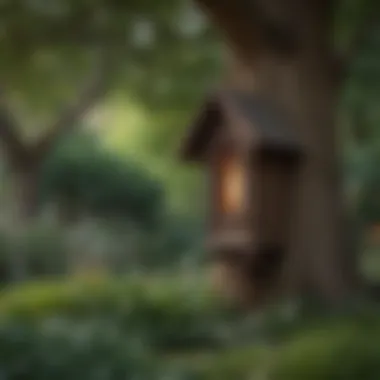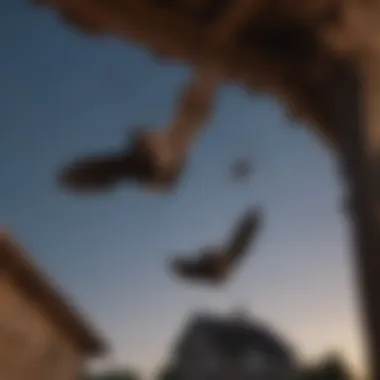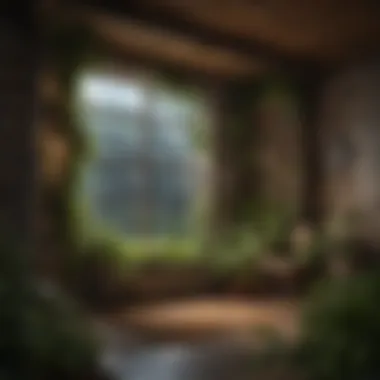Attract Bats to Your Bat House Effectively


Intro
Attracting bats to your bat house is a task that requires an understanding of their behaviors, preferences, and ecological significance. Bats are known to be incredible pest controllers, consuming vast quantities of insects. Their presence can have a positive effect on your garden and overall environment. However, enticing these elusive creatures to your specially designed bat house involves careful consideration of various factors. This guide will explore the necessary design elements, practical tips for maintenance, and budgeting aspects to help facilitate a thriving sanctuary for bats.
Design Inspiration
Creating a bat house that is inviting and conducive to bats is essential. The design should be functional yet aesthetically pleasing. With a mix of practical elements and subtle style, you can enhance both the habitat and the garden.
Trending Styles
There are several styles for bat houses that merge utility and design. Standard box-style houses are common and effective, featuring a simple structure that bats can easily access. If you desire something different, consider using multi-chamber designs. This allows for increased occupancy as some bat species prefer to roost in close quarters. Always prioritize a secure and protected area in your design.
Color Palettes
While color may not seem as critical, it does play an indirect role. Dark colors can help absorb heat, creating a warmer environment for the bats. Using shades like brown or black can help the bat house blend naturally into surroundings. This enhances the camouflage, safeguarding both the bats and their habitation.
Practical Tips
To ensure long-term success in attracting bats, it is critical to maintain and care for your bat house correctly.
Maintenance & Care
Regular checks of the bat house when it is not in use are essential. Look for signs of wear or damage. Clean out old droppings and debris annually. This not only maintains hygiene but also makes the house more inviting to new residents. Inspect the structure for mold or decay, which can deter bats.
Budgeting & Planning
Setting a realistic budget is vital in the planning phase. Assess the cost of materials, tools, and potential landscaping needs. Building a quality bat house requires an upfront investment, but the long-term benefits far outweigh these expenses.
To provide an even better environment, consider additional features like Native plants or a nearby water source, which can also attract insects, thus appealing to bats.
"Bats can consume over 1,000 insects in one night, underscoring their value in natural pest control."
By implementing these design elements and practical tips, homeowners can create a welcoming habitat that benefits not only their gardens but also the local ecosystem. Over time, this commitment to sustainability can yield significant ecological rewards.
Understanding Bats
Understanding bats is a crucial aspect for attracting them to your bat house. Bats are often misunderstood creatures, frequently associated with myths and misconceptions. To create an effective bat sanctuary, one must grasp the specific needs and behaviors of these mammals. Knowing how bats operate in their habitats informs the design and placement of bat houses. With this knowledge, homeowners can create an environment that encourages bats to settle. This not only promotes biodiversity but also maintains a healthy ecosystem.
Bat Species and Their Habitats
Bats belong to the order Chiroptera, and approximately 1,300 species exist worldwide. These species typically prefer different habitats, including forests, urban areas, and wetlands. For instance, the little brown bat commonly resides in wooded areas or near water sources. It’s essential to identify local bat species before constructing a bat house to understand their preferences. Some bats favor open areas for foraging, while others prefer darker spaces for roosting. Thus, knowing these habits increases the chances of attracting bats.
Ecological Importance of Bats
Bats play significant roles in maintaining ecological balance. Their contributions go beyond simple pest control or pollination.
Pollination
Pollination by bats is vital for many plants, especially at night. Certain fruit-bearing plants, like bananas and avocados, rely on bats for reproduction. When bats feed on nectar, they transfer pollen from one flower to another. This mutual relationship benefits both the bats and the plants. By creating a bat-friendly environment, homeowners can aid in the reproductive processes of these important flora, emphasizing the symbiotic nature of ecosystems.
Insect Control
Bats are natural insect controllers. A single bat can consume thousands of insects in one night, including mosquitoes and agricultural pests. This natural form of pest management reduces the need for chemical pesticides, benefiting both the environment and human health. Encouraging bat populations around the home can lead to a significant decrease in insect-related nuisances, showcasing bats as allies in maintaining garden and yard health.
Seed Dispersal
Certain bat species are crucial for seed dispersal. They can carry seeds over long distances, promoting plant growth in new areas. This is particularly valuable in disturbed habitats where plants need reinforcements. The capacity of bats to distribute seeds aids in reforestation efforts and fosters biodiversity. By recognizing this, homeowners can appreciate the broader ecological benefits that come from nurturing bat populations in their area.
Common Misconceptions About Bats


Despite their ecological importance, many misconceptions surround bats. They are often wrongly labeled as dangerous creatures or pests. In reality, most bat species are harmless and contribute positively to the environment. Their ability to fly efficiently, use echolocation, and maintain pest control makes them unique. Understanding these facts helps to dispel myths and encourages more people to support bat conservation efforts. By educating others on bats' true nature, more individuals might be inclined to attract them, fostering a healthy and balanced ecosystem.
Selecting the Right Location for a Bat House
Choosing the right location for your bat house is crucial for attracting these beneficial animals. Bats prefer certain environments that cater to their biological needs and behaviors. Factors such as proximity to water, shelter from the wind, and avoidance of disturbances can greatly influence the likelihood of bats taking up residence. Understanding these elements not only improves the success rate of attracting bats but also ensures their long-term presence in your yard.
Factors Influencing Bat Attraction
Proximity to Water
Having a bat house near a water source significantly enhances the chances of attracting bats. Water serves as a vital resource for drinking and also attracts insects, which are a food source for bats. When bats can find both shelter and food in close proximity, it creates a more inviting environment. Installing your bat house within 300 feet of a pond, lake, or stream can be very effective. However, remember that if the bat house is too close to water, it might be prone to flooding or other hazards, so finding a balance is important.
Shelter from Wind
Wind can be a deterrent for bats when seeking a suitable dwelling. A bat house that is sheltered from strong winds will provide a more stable temperature and a sense of security. Ideal locations are often near trees, buildings, or natural features that can break the force of the wind. If the bat house is placed in a windy area, it may discourage bats from entering. Thus, ensuring a wind protection strategy can immensely boost your bat house's effectiveness.
Avoidance of Disturbances
Bats are sensitive creatures and require a peaceful environment free from disturbances to thrive. Areas with less human activity, pets, or loud noises are preferred. If a bat house is installed near frequently visited spots, such as playgrounds or bustling backyards, bats may steer clear of it. It is wise to also observe how often wildlife or pets frequent the area. A tranquil setting allows bats to feel safe enough to roost, ultimately encouraging their habitation.
Optimal Height for Bat Houses
When it comes to height, bat houses should ideally be installed at least 12 to 15 feet above the ground. Bats prefer elevated positions to avoid predators and gain a broader view of their surroundings. However, placing the bat house higher than 20 feet could make access difficult for the bats. Finding a middle ground ensures that the house is accessible yet secure. A height within the recommended range allows bats to enter easily while protecting them from terrestrial threats.
Sunlight Requirements
Bats enjoy warm environments, and sunlight plays a significant role in regulating the temperature of their roosts. Ideally, the bat house should receive 6 to 8 hours of sunlight daily. This warmth will help keep the internal temperature suitable for bats, especially during the colder months. Conversely, too much sun may lead to overheating, so it's important to consider the local climate and positioning. Facing the bat house south or southeast can balance sunlight exposure effectively.
Designing an Effective Bat House
Designing an effective bat house is crucial for attracting bats and providing them a safe haven. A well-constructed bat house can enhance the overall experience for both bats and homeowners. It serves not only as a shelter but also as a sanctuary, promoting bat populations and aiding in ecological balance. Important elements include the materials used, the dimensions, and how well it meets the specific needs of bats.
Materials for Bat House Construction
Choosing the right materials allows for durability and comfort in a bat house. Quality wood is often a preferred material due to its strength and insulation properties. Cedar or pine is frequently used because these types of wood resist decay and help maintain temperatures inside the house. It is vital to avoid chemically-treated wood, as it can harm bats. The construction should also consider weather-resistant coatings to ensure longevity.
Dimensions and Specifications
Entry Holes
Entry holes facilitate access for bats, making them an essential component of bat house design. Ideally, the holes should be about 1 to 1.5 inches in diameter. This size strikes a balance; it is large enough for bats to enter easily while providing protection against larger predators. A well-placed entry hole contributes to the overall success of attracting bats and encourages them to roost comfortably.
Internal Space
The internal space of a bat house must be spacious enough for bats to roost without feeling cramped. Typically, a height of around 24 inches and a width of about 14 inches is recommended. This space allows for several bats to inhabit the house simultaneously. Adequate internal space reduces stress for bats and encourages colony formation, benefiting their survival and reproduction.
Ventilation
Ventilation is critical in a bat house to prevent overheating and promote airflow. Proper placement of ventilation holes ensures that hot air can escape while allowing cooler air in. These vents should be small but strategically placed near the top of the house. Effective ventilation is crucial for the health and comfort of the bats. It not only regulates temperature but also helps in reducing humidity levels.
Enhancing Comfort for Bats
Enhancing comfort for bats contributes significantly to the overall appeal of the bat house.
Roughened Interior Surfaces
Roughened interior surfaces provide bats with a grip for clinging and roosting. Like natural caverns, a textured surface mimics their natural environment, allowing bats to feel secure while roosting. This feature is a practical choice for bat houses, as it aids in their comfort and stability. Applying a rough texture can easily be accomplished by using saws or routers when constructing the house.
Thermal Insulation


Thermal insulation protects bats from extreme temperatures. This is especially important in regions with temperature fluctuations. Insulating materials can maintain a stable internal environment, ensuring that bats are not subjected to overheating or excessive cold. The use of insulation, such as polystyrene, can improve survival rates. It becomes a beneficial element in areas with harsh weather conditions.
Installing the Bat House
When it comes to attracting bats, the installation of the bat house is a critical step. It goes beyond simply placing a structure in your yard. Proper installation ensures not only that bats will find and inhabit the house, but also that they thrive there. Selecting the right location, employing proper mounting techniques, and considering environmental factors are all elements that play a significant role in the success of the bat house initiative.
Selecting the Installation Site
Choosing an appropriate site for your bat house cannot be overstated. Bats are creatures of habit and they prefer homes that meet specific requirements. Look for areas that receive ample sunlight. Ideally, the bat house should face south or southeast to maximize exposure to sunlight. This helps create a thermal environment that bats favor.
Additionally, proximity to water sources such as ponds, streams, or lakes enhances attraction; bats need to hydrate frequently.
Avoid locations that experience high wind, as extreme weather can deter bats.
Lastly, minimize disturbances; places away from heavy human activity or bright artificial lights tend to be more inviting to these animals.
Proper Mounting Techniques
Mounting the bat house correctly ensures that it is both safe and accessible. Installation at an optimal height is crucial; a minimum height of 10 to 12 feet off the ground is preferable. This placement protects bats from predators and makes the house less accessible to unintended visitors.
Furthermore, ensure that the bat house is firmly mounted to a post, tree, or building, using screws or brackets to prevent it from swinging or swaying in the wind. It is wise to avoid direct attachment to trees, as this can lead to damage to the tree and make it more difficult for bats to enter.
Consider using a mounting platform, which can provide additional stability in case of strong winds. Properly installed houses should easily withstand various weather elements, aiding in bat retention.
Environmental Considerations
Avoiding Pesticides
Avoiding pesticides near the bat house is an important consideration. Bats primarily feed on insects, and chemical pesticides can poison them and deplete their food sources. The presence of pesticides contributes to a negative ecosystem balance, deterring bats from settling in your area. This aspect emphasizes the overall goal of creating a safe and sustainable environment for bats. Doing so not only aids local bat populations but cultivates a healthier ecosystem. Choosing organic pest control options, when necessary, can help maintain the local insect population to support bats’ natural feeding habits.
Providing Natural Food Sources
Providing natural food sources is another significant factor. Bats thrive in environments rich in insects. Planting native shrubs and flowers can encourage insect populations beneficial to bats. Consider incorporating plants that bloom at night to attract moths, which are a favorite food source. By fostering a natural habitat, you contribute positively to attracting bats to your bat house. Remember, the presence of a variety of insects is crucial for bats’ sustenance. This approach minimizes the need for artificial feeding methods while enhancing biodiversity in your garden.
Proper installation of a bat house is vital for attracting and maintaining a healthy bat population in your area.
Monitoring and Maintenance
Proper monitoring and maintenance of your bat house are crucial for several reasons. First, they ensure that the house remains a safe and welcoming environment for bats. Regular checks can help identify any potential issues early, allowing for timely interventions. This proactive approach not only supports bat health but also enhances the likelihood of bats returning season after season. Second, maintaining the bat house helps protect it from damage caused by environmental factors or pests.
Regular inspections, cleaning, and addressing common issues such as predation and parasites will reinforce the efficacy of your efforts to attract and sustain bat populations. Keeping a close watch and ensuring the bat house environment is optimal can significantly contribute to the success of your bat conservation initiatives.
Regular Inspections
Conducting regular inspections of the bat house is vital. These inspections allow you to assess the overall condition of the house. Look for signs of wear and tear, such as cracks or holes, which may compromise the shelter. Additionally, check for any signs of occupancy. Bats may leave behind droppings or residue inside the house, indicating their presence.
Inspections should be carried out at least once a month, particularly during the active season, which typically runs from spring to fall. Observing bat behavior during inspections can also provide insights into their preferences and wellbeing. If bats are not showing interest in using the house, consider whether environmental conditions or placement may be affecting their attraction.
Cleaning Guidelines
Keeping the bat house clean is essential for the health of its occupants. After the bats have vacated, usually in late fall, clean the interior. Remove any accumulated droppings, which can contain harmful pathogens. A simple mixture of soap and water can be used for cleaning. Avoid using chemicals that may harm bats or disrupt their habitat.
Additionally, ensure that entrances and exits are free from obstructions. Regular cleaning not only keeps the house healthy but also encourages bats to return. They prefer a clean and well-maintained space. Ensure to check the house after bad weather, as rain or wind may deposit debris inside the house.
Addressing Common Issues
Predation
Predation is a critical consideration when setting up a bat house. Various predators may threaten bats, including larger birds and mammals. To mitigate this issue, it is essential to place the bat house in a suitable location. Elevating the house and ensuring it is away from dense vegetation can help minimize risks.


While predation is a natural part of the ecosystem, it is beneficial to keep an eye on any ongoing predation levels. If predator activity around the house seems unusually high, it might be necessary to adjust the house’s location or even the design to provide better concealment.
Parasites
Parasites can affect bat health significantly. Common parasites include mites and fleas. A clean bat house helps reduce infestations, but monitoring for parasites is key. If you notice a decline in bat activity, parasites could be a cause. In such cases, consulting with wildlife experts can provide insight into managing such issues effectively.
Differentiating between benign and harmful parasites is crucial for understanding their impact. While some may not threaten the bat population, others can lead to significant health problems. It’s crucial to maintain vigilance and address any concerns swiftly to ensure the bats in your house remain healthy and thriving.
Regular monitoring and maintenance are essential to attract and sustain a healthy bat population.
Promoting Bat Conservation
Bat conservation plays a crucial role in ecological balance and health. Bats are effective pest controllers, pollinators, and seed dispersers. Promoting bat conservation not only aids in maintaining their populations but also ensures the stability of ecosystems. As they consume vast quantities of insects, bats help reduce the reliance on chemical pesticides, benefiting both agriculture and local environments. Furthermore, preserving these creatures fosters biodiversity, allowing various organisms to thrive together.
Community Involvement
Community involvement is key in fostering a successful bat conservation initiative. Local groups can come together to form bat conservation clubs or workshops. These gatherings create awareness about bats, their benefits, and the challenges they face.
Engaging with the community helps in multiple ways:
- Organizing Bat Walks: These events encourage local residents to learn more about bats in their natural habitat.
- Creating Nesting Spaces: Groups can collaborate to build or install bat houses in parks or residential areas.
- Social Media Campaigns: Utilizing platforms like Facebook can boost awareness and share success stories.
Involvement at a community level ensures that more people understand and value the presence of bats. When locals see the benefits of bats first-hand, they become more likely to support and engage in conservation efforts.
Educating Others About Bats
Education is foundational to promoting bat conservation. Many misconceptions surround bats, leading to fear and misinformation. By providing factual information about bats, one can break down these myths. For example, educating others that bats do not seek to harm humans is vital.
Methods for effective education include:
- Workshops: Local schools and community centers can host informative sessions about bat behavior and ecology.
- Distribution of Educational Materials: Flyers, brochures, and social media posts can provide quick facts and debunk common myths.
- Hands-On Experiences: Setting up bat houses in schools can offer students a firsthand experience of observing and understanding these creatures.
When communities are educated about bats, they are more inclined to support conservation measures and coexist peacefully with these important species.
Supporting Local Conservation Efforts
Supporting local conservation efforts can significantly enhance bat populations. Numerous organizations focus on wildlife preservation and habitat restoration. Donating time or resources to these groups is beneficial. Local efforts often require volunteers for various tasks, from building bat houses to conducting surveys on bat populations.
Ways to support these initiatives include:
- Volunteer Work: Many organizations first-hand benefit from volunteers for hands-on tasks.
- Donations: Financial contributions can help fund research and conservation projects.
- Participating in Local Events: Engaging in local conservation events helps in increasing visibility and encouraging broader community participation.
By aligning with local conservation efforts, individuals contribute to a larger movement that impacts bat populations positively and supports healthier ecosystems.
"Bats are more than just flying mammals; their presence signifies the health of our ecosystem."
In summary, promoting bat conservation involves fostering community involvement, educating others, and supporting local organizations. Each of these elements plays a significant role in ensuring that bats continue to thrive in our environments.
Ending
In concluding this guide, it is important to emphasize the significance of attracting bats to your bat house. Bats provide numerous ecological benefits, such as controlling insect populations and aiding in pollination. By creating a suitable environment for bats, homeowners not only promote biodiversity but also contribute positively to the ecosystem. Working to establish a bat habitat aligns with broader conservation goals and encourages a harmonious relationship with nature.
Recap of Key Points
The process of attracting bats requires thoughtful planning and execution. Here are the key points highlighted in this article:
- Understanding Bats: Knowing about different bat species and their preferred habitats sets the foundation for successful attraction.
- Selecting the Right Location: Bats prefer roosting sites that are close to water sources, protected from wind, and away from disturbances.
- Designing an Effective Bat House: Use suitable materials and dimensions to accommodate bats comfortably. Features like roughened surfaces and ventilation play a crucial role.
- Installing the Bat House Properly: Ensure that the bat house is mounted at the optimal height and location to provide safety and accessibility.
- Monitoring and Maintenance: Regular inspections and cleaning can address potential issues, fostering a safe habitat.
- Promoting Bat Conservation: Community involvement and education about bats can enhance conservation efforts and raise awareness about their importance.
Encouragement for Homeowners
Homeowners are encouraged to take actionable steps toward creating a welcoming habitat for bats. Engaging in this endeavor can prove to be rewarding. The presence of bats brings natural pest control and enhances local ecosystems. It is vital to understand that every effort counts. By choosing to install a bat house and maintaining it responsibly, you are making a difference.
Invest in bat conservation and reap the benefits of a thriving backyard ecosystem. Remember, this task requires patience, as bats may take time to relocate to the new house. Commitment to this cause is key. Connect with your community and share your experiences, fostering a larger network of support for bat conservation initiatives.
"Bats are not just creatures of the night. They are vital players in our ecosystems, and each bat house can become a sanctuary for them."















